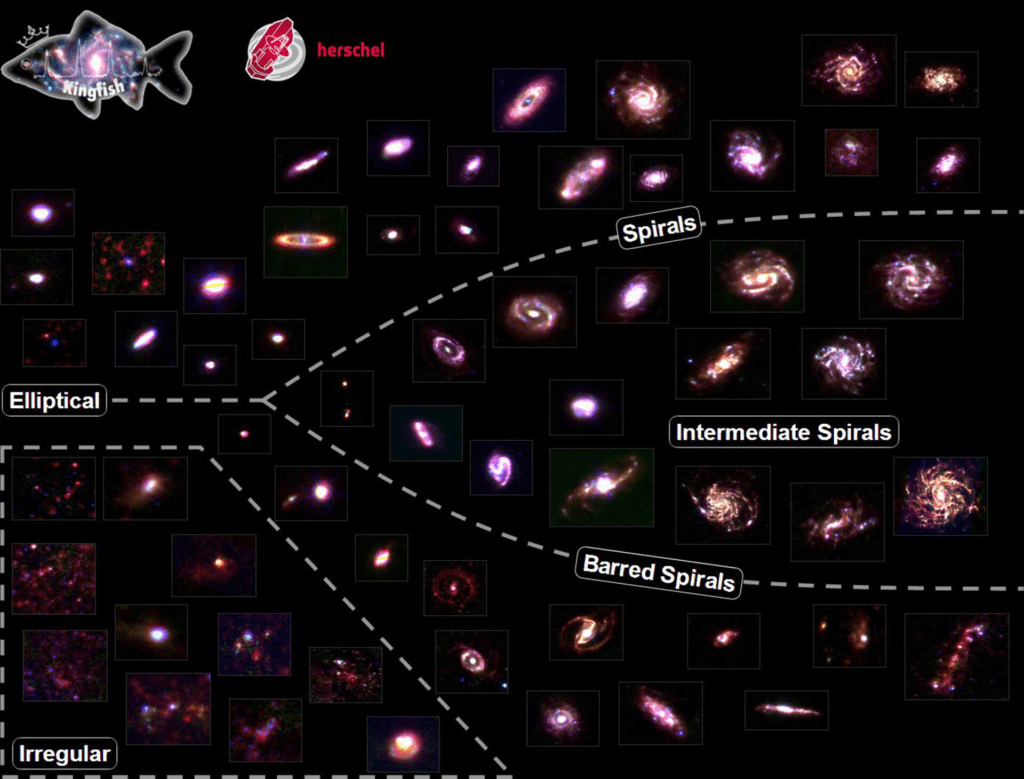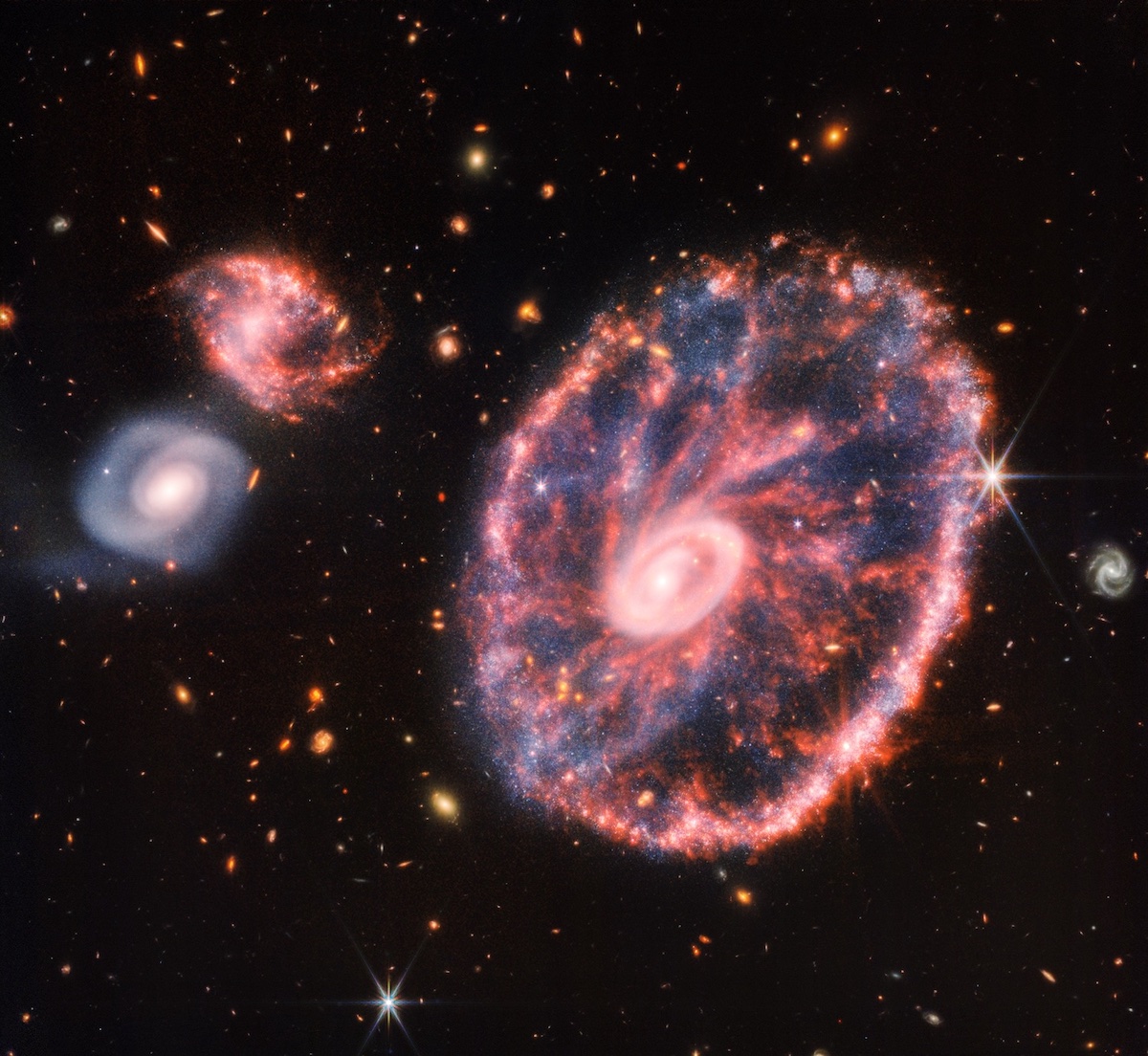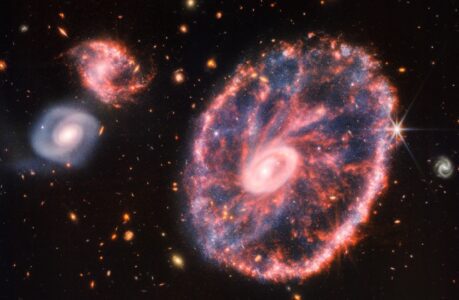Unlocking the Secrets of the Universe: A Dive into Galaxy Classification
The universe is a vast, mysterious expanse filled with countless celestial objects, and at the heart of this cosmic tapestry lie galaxies—enigmatic conglomerations of stars, gas, dust, and dark matter. Galaxies come in various shapes and sizes, each with its own unique characteristics and history. But have you ever wondered how astronomers classify these galactic giants? In this exploration of the cosmos, we will delve into the fascinating realm of galaxy classification, revealing the methods, criteria, and significance behind this astronomical endeavor.
Introduction to Galaxies
Before we embark on our journey to unravel the intricacies of galaxy classification, it’s essential to understand what galaxies are and why they hold such a prominent place in the field of astronomy.
What Are Galaxies?
Galaxies are colossal systems composed of stars, planets, gas, dust, and dark matter, all bound together by the force of gravity. These cosmic islands can vary in size from a few thousand to hundreds of thousands of light-years across, making them the building blocks of the universe. Our Milky Way, for instance, is a galaxy containing our solar system along with billions of other stars.
The Cosmic Abundance of Galaxies
To comprehend the vastness of the universe, consider this: astronomers estimate that there are over 100 billion galaxies in the observable universe. Each of these galaxies, in turn, may contain billions to trillions of stars, making the number of stars in the universe practically unfathomable. The study of galaxies not only enriches our understanding of the cosmos but also helps us glimpse the processes that have shaped the universe’s evolution over billions of years.
Now that we have a fundamental grasp of what galaxies are, let’s venture into the intriguing world of galaxy classification.
The Need for Classification
Seeking Order Amidst Chaos
The universe is a realm of diversity, where no two celestial objects are exactly alike. Galaxies are no exception, and their wide-ranging features necessitate a systematic approach to understanding and cataloging them. Galaxy classification serves as the organizing principle that allows astronomers to categorize these cosmic entities based on their observable properties.
Unveiling the Universe’s Secrets
Beyond the apparent need for order, galaxy classification is essential for several reasons. First and foremost, it aids in our comprehension of cosmic evolution. By grouping galaxies into distinct classes, scientists can discern patterns and relationships that reveal insights into the universe’s history, dynamics, and future. Furthermore, it provides a foundation for studying the formation and evolution of galaxies, shedding light on the underlying physical processes at work.
The Pioneers of Galaxy Classification
The Early Stages
The journey of galaxy classification began in the early 20th century when astronomers first recognized the diversity of galaxies in the night sky. Notably, two astronomers made pioneering contributions to this field: Edwin Hubble and Harlow Shapley.
Edwin Hubble: The Father of Modern Cosmology
Edwin Hubble, often hailed as the father of modern cosmology, played a pivotal role in understanding the nature of galaxies. In the 1920s, he made a groundbreaking discovery that forever altered our perception of the cosmos. Hubble observed that galaxies were receding from each other, indicating that the universe was expanding. This observation, known as Hubble’s law, laid the foundation for modern cosmology and firmly established the existence of galaxies beyond our Milky Way.
Harlow Shapley: The Great Debate
Harlow Shapley, another prominent figure of his time, engaged in the “Great Debate” with Heber Curtis in 1920. During this debate, they discussed the nature of spiral nebulae, which were believed to be separate galaxies or part of our Milky Way at the time. Shapley argued that they were part of our galaxy, while Curtis argued that they were distant galaxies. Ultimately, Hubble’s discoveries supported Curtis’s view, confirming that galaxies existed beyond our own.
These early astronomers laid the groundwork for classifying galaxies, but it was the efforts of subsequent researchers that refined and expanded the classification systems we use today.
Galaxy Classification Systems
The Hubble Tuning Fork Diagram
One of the most well-known and widely used galaxy classification systems is the Hubble Tuning Fork Diagram, created by none other than Edwin Hubble himself. This diagram, resembling a tuning fork, categorizes galaxies into three main classes based on their visual appearance: elliptical galaxies, spiral galaxies, and irregular galaxies.

1. Elliptical Galaxies
Shape: Smooth and featureless Characteristics: Lack spiral arms; composed mainly of older stars
Elliptical galaxies are the first prong of the tuning fork and are characterized by their smooth, round or elongated appearance. They lack the distinctive spiral arms and disk structure seen in spiral galaxies. Elliptical galaxies are often composed primarily of older stars, with little ongoing star formation. These galaxies are denoted by the letter “E,” followed by a number to indicate their degree of elongation, ranging from E0 (perfectly round) to E7 (highly elongated).
2. Spiral Galaxies
Shape: Disk-like with spiral arms Characteristics: Prominent spiral arms; ongoing star formation
Spiral galaxies form the second prong of the tuning fork and are easily recognizable by their disk-like structure and prominent spiral arms. These galaxies are often teeming with young, hot stars, indicating ongoing star formation. Spiral galaxies are denoted by the letter “S,” followed by one of several subcategories (a, b, or c), which represent the tightness of their spiral arms and other specific features.
3. Irregular Galaxies
Shape: No distinct shape Characteristics: Chaotic appearance; irregular star distribution
Irregular galaxies, as the name suggests, defy the structured appearance of elliptical and spiral galaxies. They come in various shapes and sizes, often appearing chaotic and devoid of a clear structure. Irregular galaxies can be further subdivided into two categories: Irr I and Irr II, with Irr I having some semblance of structure and Irr II appearing more disordered.
The Hubble Tuning Fork Diagram provides a visual and intuitive means of classifying galaxies based on their morphology, but it’s just the tip of the cosmic iceberg.
The Extended Hubble Sequence
The Hubble Tuning Fork Diagram, while valuable, is somewhat simplistic and doesn’t account for all the nuances of galaxy classification. To address this limitation, astronomers have developed the Extended Hubble Sequence, which incorporates additional factors beyond morphology.
1. Barred Spiral Galaxies
Characteristics: Spiral galaxies with a central bar structure
Some spiral galaxies exhibit a prominent bar-like structure that runs through their central regions. These are known as barred spiral galaxies and are denoted by adding a “B” to the classification, such as SBa, SBb, or SBc.
2. Lenticular Galaxies
Characteristics: Intermediate between elliptical and spiral galaxies
Lenticular galaxies, often abbreviated as S0, fall between the categories of elliptical and spiral galaxies. They have a disk-like structure like spirals but lack the prominent spiral arms. Lenticular galaxies are sometimes considered transitional forms.
3. Dwarf Galaxies
Characteristics: Small in size; low luminosity
Dwarf galaxies are significantly smaller and less luminous than their larger counterparts. They come in various forms, including dwarf ellipticals, dwarf irregulars, and dwarf spirals. These galaxies are essential in the study of galaxy formation and evolution, as they are thought to be building blocks for larger galaxies.
The Extended Hubble Sequence provides a more comprehensive framework for classifying galaxies, incorporating not only their visual appearance but also additional characteristics like the presence of bars and the absence of spiral arms.
Other Classification Systems
In addition to the Hubble Tuning Fork Diagram and the Extended Hubble Sequence, astronomers have developed various other classification systems based on different criteria. Some of these systems categorize galaxies based on their spectral characteristics, while others focus on their level of nuclear activity.
Spectral Classification
Spectral lines reveal information about a galaxy’s composition, temperature, and motion.
Spectral classification involves analyzing the light emitted by galaxies and identifying specific spectral lines in their spectra. These lines provide insights into the galaxy’s composition, temperature, and motion. Spectral classes include Seyfert galaxies, active galactic nuclei (AGN), and starburst galaxies, among others.
Interaction and Merging
Galaxies can interact and merge, leading to new forms and classifications.
Galaxies are not static entities; they can interact and merge with one another, resulting in new forms and classifications. Interacting galaxies often exhibit tidal tails, bridges, and distorted shapes. Examples of interactions include galaxy pairs, galaxy groups, and galaxy clusters.
Caveats and Challenges
While galaxy classification systems offer valuable insights into the cosmos, they are not without challenges and limitations. For instance, galaxies can change over time, blurring the lines between categories. Additionally, our view of galaxies is limited by factors like distance and obscuration, making it difficult to classify some objects accurately.
The Role of Technology
Advancements in technology have played a pivotal role in the field of galaxy classification. From early telescopes to cutting-edge observatories, each technological leap has expanded our understanding of the cosmos.
Early Observations
In the past, astronomers relied on rudimentary telescopes to study galaxies. These early instruments provided limited resolution and sensitivity, making it challenging to discern the finer details of distant galaxies. Nonetheless, they laid the foundation for subsequent discoveries.
Photographic Plates
The advent of photographic plates in the 19th century revolutionized astronomical observations. Astronomers could capture the faint light from galaxies over extended periods, allowing for more detailed studies. Photographs became the primary medium for recording and analyzing celestial objects.
Modern Telescopes
The development of modern telescopes, such as the Hubble Space Telescope, has transformed our ability to study galaxies. These telescopes offer unparalleled resolution and sensitivity, allowing astronomers to observe galaxies in unprecedented detail. The Hubble Space Telescope, in particular, has provided stunning images of distant galaxies, further enriching our understanding of their diverse forms.
Spectroscopy
Spectroscopy, the analysis of an object’s spectrum, has been a game-changer in galaxy classification. By dissecting the light from galaxies into its constituent wavelengths, astronomers can determine properties like chemical composition, temperature, and motion. This technique has been instrumental in categorizing galaxies based on their spectral characteristics.
Computer Modeling
Advances in computational modeling have enabled astronomers to simulate galaxy formation and evolution. These simulations help refine classification systems and provide insights into the complex processes that govern galactic dynamics.
The Role of Observations
Observations are at the heart of galaxy classification. Astronomers use a combination of visual, photographic, and spectroscopic observations to determine a galaxy’s classification. These observations capture critical information about a galaxy’s morphology, spectrum, and interactions.
Visual Observations
Astronomers often begin the classification process by visually examining images of galaxies. This step involves noting the galaxy’s overall shape, the presence of features like spiral arms or bars, and any signs of irregularity.
Photographic Surveys
Photographic surveys involve taking long-exposure photographs of the night sky to capture faint galaxies. These images provide detailed visual information about a galaxy’s structure, allowing astronomers to assign it a place within classification systems like the Hubble Tuning Fork Diagram.
Spectroscopic Data
Spectroscopy plays a crucial role in classifying galaxies based on their spectral lines. Astronomers use spectrographs to split the light from galaxies into its constituent wavelengths. By analyzing these spectra, they can determine a galaxy’s composition, temperature, and motion, leading to its classification.
Multimodal Observations
In many cases, astronomers employ a combination of visual, photographic, and spectroscopic observations to classify galaxies comprehensively. Multimodal observations provide a more complete picture of a galaxy’s properties and characteristics.
Contemporary Challenges and Future Prospects
As our understanding of galaxies deepens, new challenges and avenues for exploration emerge. Here are some of the contemporary challenges and future prospects in the field of galaxy classification.
Dark Matter and Dark Energy
The role of dark matter and dark energy in galaxy formation and evolution remains a topic of intense study. Understanding how these enigmatic components interact with galaxies and shape their destinies is a central challenge in contemporary astrophysics.
Exoplanets and Habitability
The search for exoplanets within galaxies is a burgeoning field. Astronomers are keen to identify habitable exoplanets and study their potential for hosting life. This quest extends our understanding of galaxies beyond mere classification into the realm of astrobiology.
Gravitational Waves
The detection of gravitational waves from galaxy mergers opens a new window into the universe. These waves provide direct evidence of cosmic events, such as black hole mergers, that were previously invisible to traditional observations.
Artificial Intelligence
Artificial intelligence and machine learning are becoming increasingly valuable tools in galaxy classification. These technologies can analyze vast datasets and identify patterns that may elude human observers, enhancing our ability to categorize galaxies accurately.
Future Observatories
Upcoming observatories, such as the James Webb Space Telescope (JWST) and the Square Kilometer Array (SKA), promise to revolutionize our understanding of galaxies. The JWST, with its infrared capabilities, will unveil the secrets of the early universe, while the SKA will map the cosmos with unprecedented detail.
Conclusion
Galaxy classification is a dynamic field of astronomy that continues to evolve with technological advancements and our expanding knowledge of the cosmos. From the early efforts of astronomers like Edwin Hubble and Harlow Shapley to the modern era of advanced telescopes and computational modeling, our ability to categorize galaxies has come a long way.
As we peer deeper into the universe and uncover its mysteries, galaxy classification remains an essential tool for organizing the celestial tapestry. It not only provides structure to the chaos of the cosmos but also serves as a key to unlocking the secrets of the universe’s past, present, and future.
In the ever-expanding cosmos, galaxies are the stars of the show, and their classification is our roadmap to understanding the grand narrative of the universe. So, the next time you gaze at the night sky, remember that each twinkling point of light represents a galaxy, waiting to be classified and revealing its own unique story in the cosmic drama.

